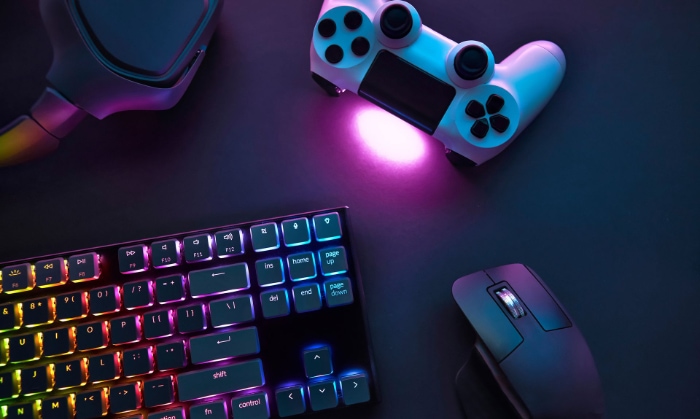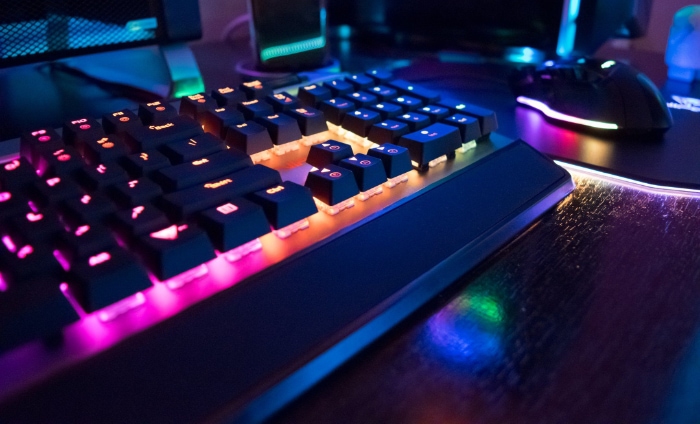2.4GHz vs. Bluetooth: Choosing Your Wireless Ally

Wireless connectivity has ushered in a new era of gaming, where the tether to our devices is no longer physical but digital. This advancement brings to the forefront two dominant wireless technologies: 2.4GHz and Bluetooth.
Each offers a unique blend of performance and convenience, catering to the diverse needs of the gaming community. From the responsiveness required in competitive gaming to the ease of use for casual play, the choice between these technologies can significantly impact a gamer's experience.
Wireless Technologies in Gaming
Wireless technology has become a game-changer in the way we interact with our gaming devices. Offering freedom from cables and the ability to move without restraint, it's crucial for gamers to choose the right type of wireless connection.
2.4GHz Wireless Technology
2.4GHz wireless technology is a common method for connecting devices over short distances. It operates within the 2.4GHz frequency band, a range widely used by various devices, from wireless keyboards and mice to Wi-Fi routers.
For gaming gear, a dedicated receiver plugged into the USB port of a computer or console ensures a direct and stable connection. This setup is favored for its minimal latency, a vital factor for competitive gaming where every millisecond counts.
A 2.4GHz connection transmits data over a wide range of channels within the 2.4GHz spectrum. It avoids interference by hopping between channels, maintaining a clear path for data.
This technology is designed to support the fast-paced data transmission required by gaming peripherals, delivering real-time responsiveness.
Application in Gaming Gear
Gaming mice, keyboards, and headsets using 2.4GHz wireless technology are renowned for their speed and reliability. By employing a dedicated dongle, they establish a direct connection with the device, bypassing the crowded airwaves often saturated by other wireless signals.
This ensures consistent performance, crucial for gaming environments where precision and timing are everything.
Bluetooth Technology
Bluetooth is a widely used wireless technology that enables devices to communicate over short distances. It's built into many modern computers and gaming consoles, making it a convenient option for connecting peripherals without the need for additional receivers.
Bluetooth's evolution has seen improvements in speed, energy efficiency, and connection stability, making it more viable for gaming than ever before.
Over the years, Bluetooth technology has undergone significant enhancements. Newer versions, such as Bluetooth 5.0 and beyond, offer increased range, higher data transfer rates, and better coexistence with other wireless technologies.
These advancements reduce the latency and connection issues that earlier versions faced, addressing concerns that once made gamers wary.
Bluetooth in Gaming Peripherals
Bluetooth's versatility and widespread integration in devices make it a popular choice for wireless gaming peripherals. It supports a seamless connection process, allowing gamers to pair their devices quickly.
While historically viewed as less reliable for fast-paced gaming due to potential latency issues, advancements in Bluetooth technology have significantly narrowed the performance gap between it and its 2.4GHz counterpart.
Connectivity and Compatibility
Selecting wireless gaming peripherals hinges on their compatibility with gaming setups and the connectivity they offer. With 2.4GHz and Bluetooth being the primary choices, each technology caters to different aspects of these needs.
Connecting and Matching Devices with 2.4GHz
To connect a 2.4GHz wireless device to a computer or gaming console, a small USB receiver is typically used. This receiver, often referred to as a dongle, is plugged into the USB port of the device.
Once inserted, it automatically communicates with the peripheral, establishing a secure and dedicated connection. This process is straightforward, requiring minimal setup from the user, and eliminates the need for in-built Bluetooth support.
Compatibility Considerations
One of the strengths of 2.4GHz devices is their broad compatibility. Since the connection is facilitated through a USB receiver, they can be used with almost any system that has a USB port.
This includes PCs, Macs, and most gaming consoles. However, the reliance on a USB port means that devices without one, such as some tablets and smartphones, may not be supported.
Additionally, using multiple 2.4GHz devices simultaneously can occupy multiple USB ports, which might be a limitation for users with a high number of peripherals.
Bluetooth Connections in Gaming
Bluetooth technology facilitates a seamless and versatile connection between devices without the need for external receivers. Its integration in a wide range of devices from smartphones to gaming consoles makes it an accessible option for many gamers.
Pairing Process
Connecting Bluetooth devices to a gaming system involves a pairing process. This is initiated from the Bluetooth settings menu of the device, where the peripheral in pairing mode is selected from a list of available devices.
Once selected, the device and the peripheral establish a connection, usually without requiring a passcode. The simplicity of this process and the elimination of additional hardware make Bluetooth a convenient option for connecting gaming peripherals.
Compatibility and Limitations
Bluetooth's compatibility across different platforms is one of its significant advantages. Its support is built into many modern operating systems, making it easy to connect peripherals to PCs, Macs, and mobile devices.
However, not all gaming consoles have native Bluetooth support for third-party peripherals, which can limit the use of Bluetooth gaming devices with certain consoles. Furthermore, Bluetooth connections can sometimes experience interference from other devices operating on the same frequency, which may affect performance.
Despite these challenges, Bluetooth continues to evolve, offering better stability and connectivity options for gamers.
Performance and Reliability

The choice between 2.4GHz and Bluetooth impacts not just how devices connect, but also how reliably and quickly they respond during critical gaming moments.
2.4GHz Performance and Stability
For gamers, every fraction of a second matters, making the performance and reliability of their wireless connections paramount. The 2.4GHz frequency band, widely adopted for wireless gaming peripherals, offers insights into how modern gaming experiences are shaped by technology.
Impact of Latency and Interference
Latency, or the delay between an input on the peripheral and the action being executed on-screen, is a critical consideration for gamers. Devices operating on 2.4GHz generally offer low latency, which is ideal for fast-paced games where timing is crucial.
However, interference can be a concern, especially in environments with numerous wireless devices. Despite this, 2.4GHz technology includes mechanisms to minimize interference, such as dynamic channel selection, helping maintain a stable connection even in crowded wireless environments.
Consistency in Wireless-Dense Areas
The reliability of 2.4GHz connections in areas dense with wireless signals is a testament to the robustness of the technology. Through advanced communication protocols, 2.4GHz devices can maintain a consistent connection by avoiding congested channels and mitigating the effects of interference.
This makes 2.4GHz a reliable choice for gaming in environments where many devices may be competing for wireless bandwidth.
Bluetooth's Evolving Role in Gaming Performance
As Bluetooth technology advances, it becomes an increasingly compelling option for gamers. With each iteration, Bluetooth aims to address the needs of a fast-moving industry, focusing on reducing latency and enhancing precision.
Tackling Latency and Precision
The primary concern with Bluetooth in gaming has traditionally been latency. However, recent versions of Bluetooth have made significant strides in reducing delay, approaching the responsiveness that gamers expect from their peripherals.
Precision, too, has seen improvements, with enhanced algorithms for signal processing ensuring that the intended actions are accurately reflected in-game.
Advances in Stability and Reduced Interference
The latest Bluetooth standards introduce features specifically designed to improve the connection stability and reduce interference. Techniques like frequency hopping and increased data transmission rates ensure that Bluetooth devices can coexist more harmoniously with other wireless technologies.
These advancements help mitigate potential disruptions during gameplay, offering a smoother and more reliable gaming experience.
Comparing Power Use in Wireless Technologies
Wireless gaming peripherals have transformed the gaming experience, offering freedom from cables and the flexibility to move. However, this convenience comes with the need for power, usually supplied by batteries.
2.4GHz Technology and Power Efficiency
Devices that use 2.4GHz wireless technology are designed for performance, prioritizing low latency and stable connections. This focus on speed and reliability often means that 2.4GHz devices consume more power.
The technology requires a constant signal, even when the device is not actively in use, leading to higher power consumption. As a result, peripherals using 2.4GHz may have a shorter battery life, necessitating more frequent charging or battery replacements.
Bluetooth and Its Impact on Battery Longevity
Bluetooth technology, particularly in its more recent iterations, is engineered with power efficiency in mind. Bluetooth devices can enter low-power modes when not in active use, significantly extending battery life.
This ability to manage power consumption dynamically makes Bluetooth an attractive option for gaming peripherals that don't need to be charged as often. Gamers who prefer longer play sessions without the interruption of recharging will find Bluetooth devices to be more accommodating.
The Balance Between Performance and Battery Life
The trade-off between performance and battery life is a crucial consideration for wireless gaming peripherals. 2.4GHz technology, while often offering superior performance, may lead to more frequent charging breaks.
On the other hand, Bluetooth's power efficiency can reduce the hassle of charging, but it may come with slight compromises in latency and connectivity in certain environments.
Range and Connectivity Issues
When integrating wireless devices into a gaming setup, the distance between device and receiver and the obstacles in between play crucial roles in the quality of the connection.
The Range of 2.4GHz Devices
Typically, 2.4GHz wireless devices offer a strong connection up to 9 meters (about 30 feet) in open space. This range is sufficient for most gaming setups, allowing freedom of movement without losing connection.
However, the effective range can be significantly reduced by walls, furniture, and other physical obstacles, which may absorb or reflect signals, leading to potential connectivity issues or degraded performance.
The construction materials of your gaming space can also impact the signal strength of 2.4GHz devices. For instance, metal objects and electronic devices emitting their own signals can cause interference, while thick walls may obstruct the signal path.
To mitigate these issues, positioning the receiver and gaming peripherals strategically can help maintain a strong connection, ensuring an uninterrupted gaming experience.
Bluetooth Connectivity Range
The range of Bluetooth devices is typically divided into classes, with most gaming peripherals falling into Class 2. These devices have an average range of approximately 10 meters (about 33 feet), adequate for most gaming setups.
However, like 2.4GHz technology, the actual effective range can be influenced by the environment, including walls and other barriers.
For gamers using Bluetooth peripherals, it's important to stay within the optimal range to avoid disconnections or lag. Ensuring a clear line of sight between the device and the receiver can enhance connectivity.
Additionally, being mindful of other wireless devices in the vicinity can help reduce interference, preserving the integrity of the Bluetooth connection.
Conclusion
Choosing the right wireless technology for gaming peripherals involves a careful consideration of several factors, including connectivity, performance, power consumption, range, and cost. Both 2.4GHz and Bluetooth offer distinct advantages.
2.4GHz technology is renowned for its low latency and stable connection, making it ideal for competitive gaming where every millisecond counts. On the other hand, Bluetooth stands out for its convenience, power efficiency, and the ability to connect multiple devices without the need for extra dongles, catering well to casual gamers and those who prioritize ease of use and longer battery life.
The decision between 2.4GHz and Bluetooth ultimately hinges on the specific needs and preferences of the gamer. Factors such as the gaming environment, the types of games played, and the desired balance between performance and convenience play critical roles in this choice.
Gamers are encouraged to evaluate their personal gaming setup and what they value most in their gaming experience.
Selecting the appropriate wireless gaming gear is a personal journey that varies from one gamer to another. Whether prioritizing the uninterrupted performance of 2.4GHz devices or the versatility and ease of use offered by Bluetooth, the best choice is one that aligns with your unique gaming style and preferences.


